The dog Laika, the first living being to orbit the Earth, lives on in our memories along with her lethal Sputnik 2 mission, on which she was an unwitting pioneer in the USSR’s space program more than 57 years ago.
Her story is central to Lasse Hallström’s 1985 movie, “My Life as a Dog”, and the 2005 Arcade Fire song, “Neighbourhood #2 (Laika)”. She’s had bands named after her, monuments erected to her, and countless mementos made with her image.
Laika is not the only canine cosmonaut that died at the hands of the Soviet space program; more than a dozen other dogs lost their lives before her. (Similarly, during the Cold War-fuelled Space Race, NASA in the United States sacrificed several monkeys and apes to test flight conditions for humans.)
But some Soviet space dogs survived and went on to live relatively normal lives. The next mutts launched into orbit — Belka and Strelka — landed safely, and became beloved pop stars at a time when the USSR frowned on celebrating individual achievements. Laika, Belka, Strelka, and other publicized dog cosmonauts symbolized the ultimate Soviet heroism, seen as simple creatures laying down their lives for their country and the advancement of science. Everything from stamps and postal covers to toys, children’s books, cigarette packages, and candy tins featured these furry icons.
Damon Murray, co-founder of FUEL Design and Publishing in London, came up with the idea to put a book together about the true story of these early space explorers. He collected the images; commissioned Dr. Olesya Turkina, a senior research fellow at the Russian Museum, to write the text; and edited, designed, and published the book with his business partner Stephen Sorrell. The resulting Soviet Space Dogs is a gorgeous work of art, containing adorable image after adorable image of the strays recruited against their will to pave the way for the first man is space, Russian cosmonaut Yuri Gagarin, who orbited the Earth in 1961. Citing Turkina’s text and mining his own expertise, Murray answered our questions about this history via email.
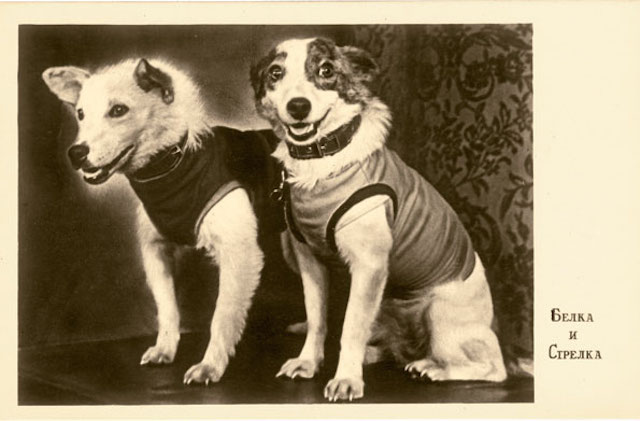
A postcard featuring a photograph taken at the space dogs’ first press conference. The text reads, “Belka and Strelka.” (© FUEL Publishing)
Collectors Weekly: How did Soviet ideology influence the USSR space program?
Damon Murray: Ideologically, socialism could not be seen to fail in any way; it was for this reason that the Soviet space program was kept so secret. It was vital that technological advances were not revealed — both the USSR and the USA attempted to keep any developments they made from each other in what became known as the Space Race.
The flights with dogs were made to determine the effects of space on living organisms. No being had ever experienced such extremes — take-off and landing, zero-gravity. These were all being carefully tested and monitored by Soviet space-program scientists so they could determine whether space-flight was safe for humans.

A 1961 confectionary tin with a portrait of Zvezdochka. The text reads, “Zvezdochka.” (© FUEL Publishing / Marianne Van den Lemmer)
Collectors Weekly: Why were dogs chosen over apes or cats?
Murray: Dogs had a history of scientific experimentation in the USSR. Petrovich Pavlov had used them to great effect in his studies of the reflex system. Despite this, apes were initially considered as they more closely resemble man in many ways. Dr. Oleg Gazenko, one of the leading scientists of the space program, even visited the circus to observe the famous monkey handler Capellini, who convinced him that monkeys were, in fact, problematic. They required intense training and numerous vaccines and were emotionally unstable. (Cats did not tolerate flight conditions; that was later proved by French missions in 1963.) The decision was made: Dogs would be the first cosmonauts.
Stray dogs were selected from the streets surrounding the space program’s research center, the Institute of Aviation Medicine, in Moscow. Strays were assumed to be much hardier than purebred dogs, as they had to fend for themselves on the city’s streets. They were selected by weight and dimension: No heavier than 6 kilograms and no taller than 35 centimeters.

A 1960 Italian postcard with an image of Kozyavka, wrongly named as Laika on the reverse. (© FUEL Publishing / Marianne Van den Lemmer)
Collectors Weekly: In the beginning, dogs were sent at least 100 kilometers above sea level, but not into orbit. Can you describe these suborbital missions?
Murray: Dezik and Tsygan were the first dogs to be flown in a rocket on July 22, 1951. The scientists were overjoyed at their safe return, running towards the safely landed capsule (even though this was strictly forbidden), shouting “They’re alive! Alive! They’re barking!” Even the head of the space program Sergey Korolev, known as the Chief Designer, allowed himself a moment of celebration — grabbing one of the dogs into his arms and running around in joy. Only a week later Dezik would die alongside another dog, Lisa, when their capsule’s parachute failed to deploy.
The exact number of flights is still unknown, but it is estimated that between July 1951 and November 1960 more than 30 suborbital flights were launched. At least 15 of the dogs involved in these flights died. One lucky dog, Bobik, managed to escape immediately before the mission. He was replaced with another stray who was appropriately named ZIB — these initials stood for Zamena Ischeznuvshevo Bobik, “Replacement for the Disappeared Bobik.”
Collectors Weekly: What became of the dogs after their missions?
Murray: After a successful mission, the dogs were generally used for propaganda purposes. For example, the dog Otvazhnaya (meaning “Brave”) earned her name after her fourth mission. She survived many flights, and became the main hero in the popular children’s book, Tyapa, Borka, and the Rocket, by Marta Baranova and Yevgeny Veltisov. Some dogs were adopted by the scientists who looked after them, as the bond between dogs and human was considerable. For example, after her last mission, the dog Zhulka (formerly “Kometa”) was taken home by the lead scientist Oleg Gazenko. She lived happily in his house for another 12 years. Other dogs spent the rest of their lives at the Institute of Aviation Medicine, like Belka and Strelka, who were the first dogs — indeed, the first living beings — to return safely from orbiting the Earth. They were regarded as celebrities, appearing on television and radio programs of the time.
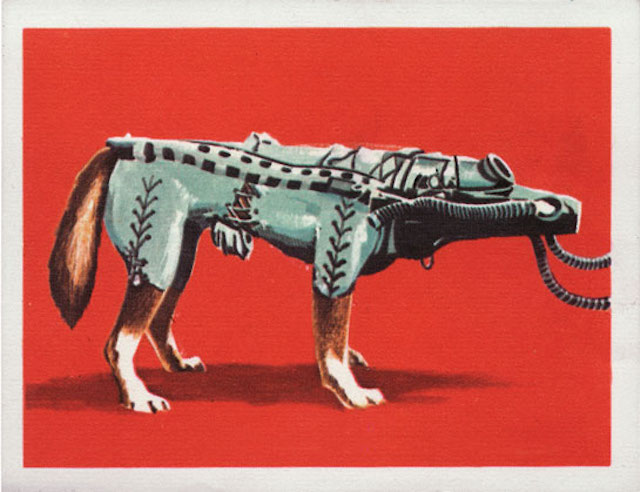
The text (in French and Dutch) on the reverse of this 1964 Jacques chocolate card, “Assault on the Stars,” explains how dog astronauts helped man explore the physical effects of space flight. (© FUEL Publishing / Marianne Van den Lemmer)
The dogs were regarded as heroes of the USSR. They were respected for doing their job for the good of country, and also humanity as a whole. Faith in progress and an ability to sacrifice oneself for the common goal became the foundation for personal and communal heroism, forcing the Soviet citizens to work miracles. For the sake of the great goal, it was possible not only to sacrifice oneself, but also other living creatures, who were believed to possess such human qualities as courage and dedication.
Collectors Weekly: How did the scientists and engineers feel about the dogs they worked with?
Murray: There are many accounts of how devoted the scientists became to their charges. Even the Chief Designer, Korolev, when he once found the dogs’ bowls empty, sent a guard to the stockade. Before her flight, the same Chief Designer whispered into the ear of the cosmonaut Lisichka (meaning “Foxy”): “It is my deepest desire that you come back safely.” Lisichka died. Because of the secrecy surrounding the program, it was unthinkable that the four-legged heroes who perished in these experiments might receive a stately burial. So the scientists were unable to mourn. But there were exceptions. In 1955, after the death of his favourite dog, Lisa 2 (meaning “Fox”), Aleksander Dmitriyevich Seryapin, an employee at the Institute of Aviation Medicine, defied regulations and buried her remains on the steppe, even bringing a camera to surreptitiously photograph the spot as a memento.
Commenting on the death of Laika in Sputnik 2, one of the leading scientists, Oleg Gazenko stated that: “Working with animals is a source of suffering to all of us. We treat them like babies who cannot speak. The more time passes, the more I’m sorry about it. We shouldn’t have done it. We did not learn enough from the mission to justify the death of the dog.”
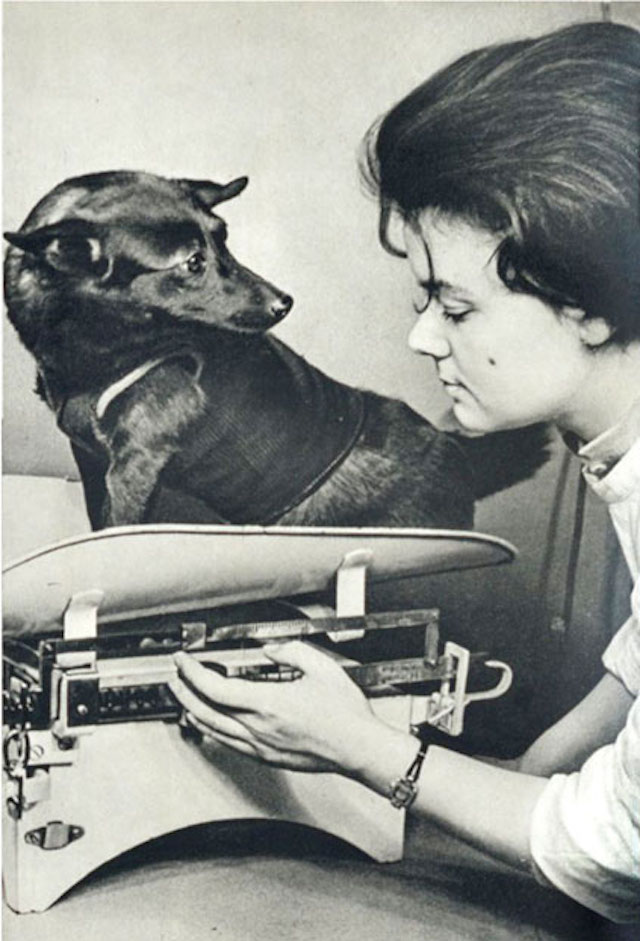
Lyudmila Radkevich, associate researcher at the Institute for Aviation and Space Medicine, checks Chernushka’s weight in the laboratory in 1958. (© FUEL Publishing)
Collectors Weekly: How did the dogs eat and relieve themselves onboard?
Murray: The problem of feeding the dogs in zero-gravity was solved by bonding nutrients with agar, a jelly-like substance. This “jelly” could then be easily consumed, minimising waste. The most tricky obstacle for the dogs travelling into space was to find a way for them to relieve themselves in such unusual conditions. Although their suits had special receptacles for urine and feces, it was difficult to train the dogs to use them. They prefer to relieve themselves outdoors, never inside a room or a cockpit, and certainly not inside clothes. This process was unnatural for the dogs, only those who took to it more easily were selected. For orbital flights, all the dogs were exclusively female: As there was no room in the cabin to cock their legs, they were better suited to space.
Collectors Weekly: How did Laika get selected to be the first dog in orbit?
Murray: Laika was chosen because during pre-flight training, she had demonstrated an exceptional capacity for endurance and tolerance. These were the admirable characteristics that would condemn her to a martyr-like death for the benefit of the human race. In addition, she was a striking dog, light in colour but with dark brown spots on her face, which possessed a surprised expression. Crucially, her image reproduced well in black-and-white photographs and film footage. This was an important factor, as it was recognised that the launch would be historically significant and, therefore, would be meticulously recorded.
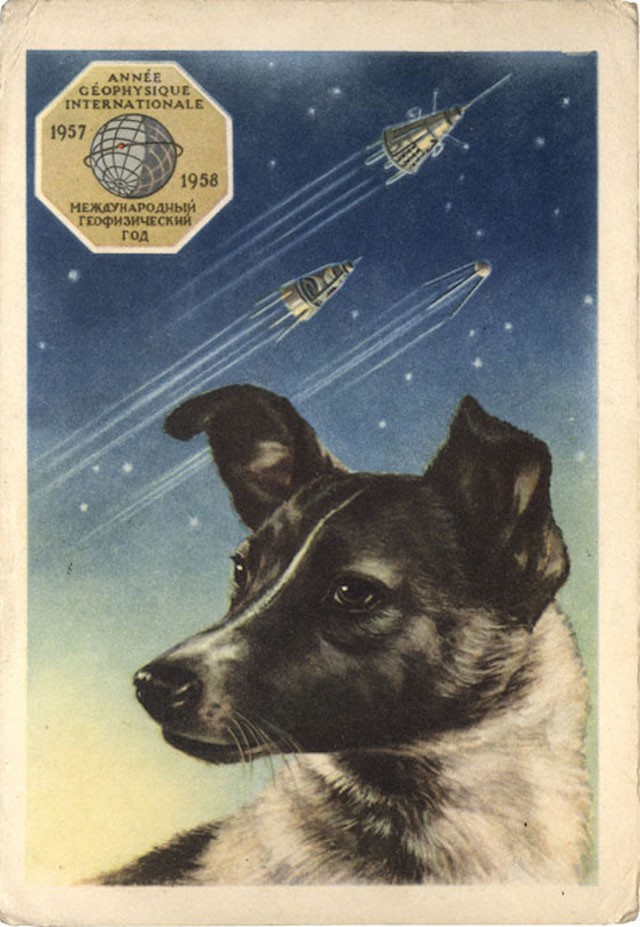
A portrait of Laika by the artist E. Gundobin, with the first three Sputniks in the background. Text of this 1958 postcard from the USSR reads “International Geophysical Year 1957 — 1958.” (© FUEL Publishing)
Collectors Weekly: Can you describe the flight of Belka and Strelka?
Murray: The launch of the rocket containing Belka and Strelka took place on August 19, 1960, at 15:44:06. Alongside Belka and Strelka, the space mission included an ejecting container with twelve mice, insects, plants, fungi cultures, various germs, sprouts of wheat, peas, onions, and kernels of corn. In addition, the cabin contained twenty-eight lab mice and two white rats.
Only after the first orbit did the dogs begin to bark. Dr. Vladimir Yazdovsky, the lead scientist of biological research in the upper layers of the atmosphere and outer space, declared that as long as the dogs were barking, and not howling, they were sure to return to Earth. A huge step forward was the televisual transmission from the spacecraft, which allowed the scientists to closely monitor the dogs in flight for the first time. They became so quiet at the launch, that were it not for data from sensors attached to their bodies, it would have been difficult to ascertain whether they were still alive.
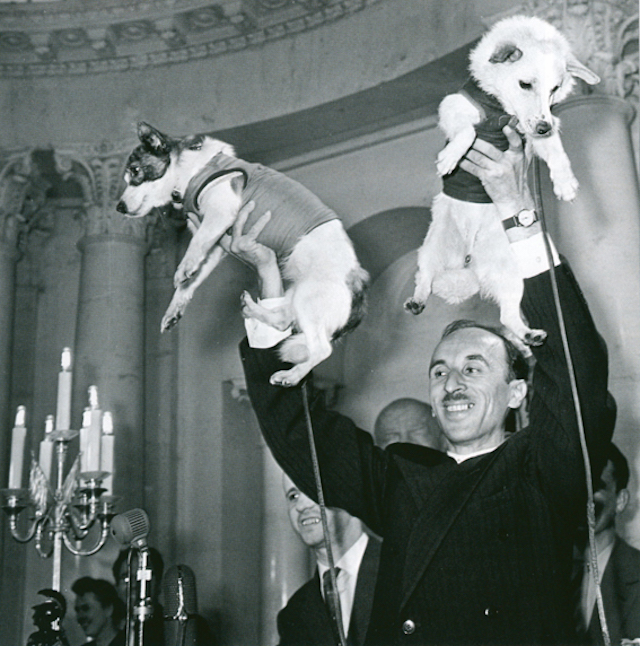
Soviet space researcher Oleg Gazenko holds Strelka (left) and Belka (right) aloft at the 1960 press conference immediately after their landing. In his memoirs, Gazenko referred to this as the proudest moment of his life. (© FUEL Publishing)
As expected, owing to the g-forces of blast-off, their heart rates and breathing had speeded up, but they quickly returned to normal. However, on the fourth orbit, Belka began to wriggle out of her harness, barking and vomiting. This reaction played a key role in the subsequent decision to send the first human cosmonaut into space for the shortest period possible: a single orbit. Belka and Strelka remained in flight for more than 24 hours, allowing the scientists enough time to study the prolonged influence of zero-gravity and radiation on live organisms. During the 18th orbit, on August 20, at 13:22:00, the order was given to decelerate, and a short time later the re-entry capsule containing the dogs landed safely on the ground.
Collectors Weekly: Why were the capsules outfitted with self-destruct mechanisms?
Murray: The importance of the advanced technology of the spacecraft meant that it was vital they did not fall into the hands of the USSR’s competitors in the space race: the USA. During the orbital space flight of a mission on December 1, 1960, the trajectory of the re-entry module deviated from the programmed course. When the system registered the risk of landing outside USSR territory, the on-board self-destruct mechanism was activated. The dogs Mushka and Pchyolka, who had orbited the Earth 17 times, were killed in this way.
Collectors Weekly: What was the Bion program and what did it symbolise between the US and USSR?
Murray: The Bion program, in contrast to the dog program, was not only concerned with the possibility of sending animals into space, but also with the complexities of sustaining living beings in orbit for extended periods of time. It began in the USSR in 1973, and in 1975, American scientists were invited to participate. The Bion project played a special role in dissipating the Cold War ideological opposition between the forces of “Good and Evil,” which had been the basis of propaganda in both the USA and the USSR.
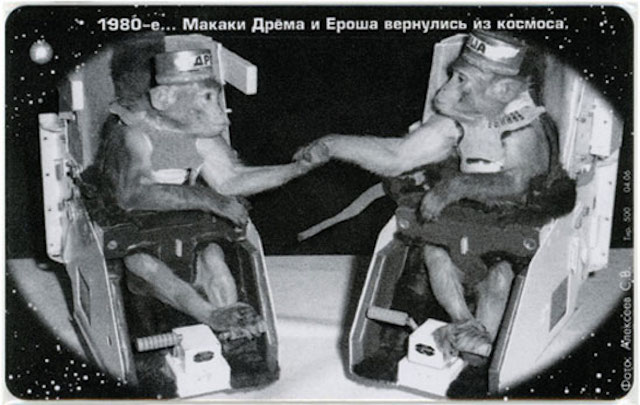
A 1991 phone card showing two of the Soviet space monkeys who followed the dogs into space. The text reads, “1980s… The monkeys Dryoma and Erosha return from space.” (© FUEL Publishing / Marianne Van den Lemmer)
Collectors Weekly: Why were monkeys chosen for Bion instead of dogs?
Murray: Monkeys were chosen for the Bion program as their physical make-up is so similar to that of a human. All the monkey pilots would have their tails removed so they could fit into their capsules. They would also have electrodes implanted in their brains. In his memoirs, Oleg Gazenko, the scientist who prepared the monkeys for their flights, professed that it was impossible not to feel pity for the outstretched monkeys, lying on the surgical table with wires protruding from the shaved crowns of their heads.
The monkeys did not fare well. The last crew spent 15 days in space, from December 24, 1996, until January 7, 1997. This flight of Multik and Lapik was sponsored by the Americans. By that time the Soviet Union had ceased to exist, so there was no funding for the space program. After landing, Multik died in surgery, following an adverse reaction to anesthetic. Multik’s death was the end of the monkey space program. The USA refused to participate further, even though another satellite launch with two apes had already been planned. The experiments were stopped as a result of both the influence of public opinion and the lack of resources. In 2010, the monkey Krosh, a space veteran, died at the age of 25. He and his comrade, Ivasha, were sent into space for 12 days at the end of 1992. He spent his final years with his offspring at the Adler Institute, where he lived as an honorary retiree — the last monkey-cosmonaut in Russia.
This article has been excerpted with permission from Collectors Weekly. To read in its entirety, head here.
To subscribe to updates from Collectors Weekly, you can like them on Facebook here or follow them on Twitter here.
